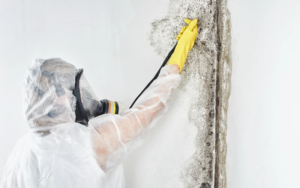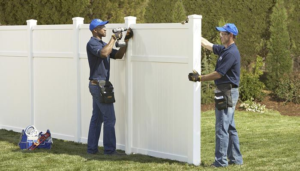Mold Remediation Salt Lake City is removing and cleaning mold-contaminated areas. The goal is to eliminate and prevent the spores from spreading to other building areas.
This requires a thorough inspection and assessment. It also involves fixing any water issues that contribute to the mold growth and sanitizing affected surfaces.

In order to minimize the spread of mold spores, isolating the affected area of your home or building is essential. This helps to safeguard the health and safety of the occupants, as well as the remediation professionals working in your space. It also prevents the spores from spreading to unaffected areas of the property as they are cleaned and disinfected.
To contain the mold, the professionals will put up protective barriers. This includes the use of containment and air filtration systems that will keep spores from entering or exiting the contaminated area. This will be done using heavy duty plastic that can be stretched across doorways or constructed around the contaminated area. A fan exhausted to the outside can be used to maintain negative pressure within the containment.
The type of containment will depend on the size of the impacted area, as well as the level of contamination. The choice of full or limited containment will be based on the professional judgment of the lead mold remediator.
Once the contained area is a safe place to work, the mold removal and cleaning process can begin. The workers will wear personal protective equipment (PPE) during this step, which can include disposable paper overalls and a face mask that fits snugly over the nose and mouth. It’s important that these masks are affixed tightly to the wearer’s head, so that spores don’t blow out of them during the cleanup.
If a large amount of contaminated material must be removed from the area, it’s usually a good idea to double-bag it before disposal. This will minimize the spread of mold spores throughout the building as it’s moved to trash. It will also help to reduce the cost of the project, since some materials may be able to be reused.
The contaminated building materials and furnishings that can’t be reused are usually disposed of as construction waste. The mold spores that are disturbed during this part of the process can become airborne, posing a respiratory risk. This is especially true if the building materials are porous, such as drywall, or if invasive procedures must be used to examine or remove mold growth within a wall cavity.
Cleaning
Depending on the material it grows on, mold can be cleaned using different methods. Surfaces like walls and carpet can be cleaned with detergents or antimicrobial chemicals. Porous materials such as drywall and carpeting may need to be removed and replaced. This can be a costly part of the remediation process.
Cleaning may be done by hand or with commercial equipment. In the case of large areas, professional cleaners are often used. A mold expert should be consulted to determine the best course of action.
If spores are airborne, the affected area is usually quarantined to prevent them from spreading to other parts of the house. This is especially important if there is an outbreak of Stachybotrys chartarum or other hazardous species.
It’s also necessary to remove and replace any contaminated building materials that can’t be cleaned and sanitized. These can include drywall, ceiling tiles, and carpeting. A hazardous waste company can transport and dispose of these materials safely.
This step may also involve the use of antimicrobials to kill remaining mold spores and prevent future growth. In addition, the area will be aired out to dry and dehumidify it. Industrial fans, air movers, and dehumidifiers are typically employed to accomplish this task.
Once the contaminated area is contained and cleaned, it’s essential to repair any damage caused by the mold infestation. This will ensure the area is safe and habitable.
A final inspection will be conducted to ensure that the infestation is eliminated and that the home or business is restored to normal. Mold remediation is a process that should only be performed by a certified mold removal contractor. This is particularly important for severe cases that can lead to toxic symptoms in individuals with respiratory problems, allergies, or weakened immune systems.
Moisture control and prompt repairs can help to prevent future mold growth in the same location. However, it’s impossible to completely eliminate all mold spores. If there’s an underlying water problem that continues to cause moisture in the area, it’s likely that the mold will return.
Disinfection
Once all visible mold has been cleaned, a professional should disinfect the affected area and the cleaning materials. This step kills any remaining mold spores and prevents them from spreading to other parts of the home or business during the next cleaning steps. This involves using a non-ammonia, detergent-based bleach solution. This product can be purchased from any hardware or home improvement store and is safe for use with any surface material, including wood.
After using the bleach solution, it is important that the area be thoroughly dried. To speed up the drying process, a dehumidifier or fans can be used. It is also a good idea to seal any contaminated materials (such as scrub brushes, sponges and disposable clothing) in plastic bags before disposing of them. Moisture should be kept to a minimum to keep the mold from returning.
Some porous materials, such as carpeting and fabric-covered furniture, should be thrown away rather than being cleaned. Mold can grow in the empty spaces and crevices of these items, and it is difficult to get rid of all the spores with a simple cleaning. A hazardous waste company can safely dispose of these items for a fee.
If the underlying cause of the mold is a water problem, such as a leaky roof or a plumbing issue, it should be repaired immediately. This will prevent the mold from coming back, and it may also help to save the items that were damaged by the moisture.
Once all the mold has been removed, a clearance test should be performed to ensure that the area is ready for reconstruction and occupancy. The expert will look for humidity and moisture readings to make sure that the area has been properly remediated. If there are any concerns, the expert will re-inspect the area and perform additional tests.
Disposal
It’s essential that items infected with mold are thrown away as soon as possible. This helps limit the spread of mold to other parts of the house and decreases the amount of toxic spores that are released into the air. It also ensures that the mold is not recycled through continued contact with new surfaces, such as walls and floors. To prevent recurrence of mold, it is vital to fix leaks as soon as they occur, keep humidity levels low, and maintain proper ventilation.
Clothing and textiles can be contaminated by mold in several ways. Washable fabrics can often be salvaged if they are thoroughly cleaned with a mold-killing product. Delicate fabrics that are heavily contaminated will need to be discarded. This process requires a discerning eye, taking into account material, sentimental value, and effectiveness of cleaning methods.
During the removal process, all affected materials are removed from the property and transported to a safe disposal area. The disposal process may require the use of biocides, which are chemical compounds approved by the Environmental Protection Agency (EPA) to kill mold spores and other harmful microorganisms. Biocides are toxic and need to be disposed of properly, which is why it is important to work with a hazardous waste company that is familiar with these chemicals and can dispose of them in accordance with state and federal regulations.
The entire cleanup and remediation process can take between one to five days. Once all the work is completed, it’s time to re-inspect and verify that all signs of mold damage have been resolved. It’s also essential to test the home’s moisture level to make sure that all areas have been properly dried and dehumidified.
If any moisture problems remain, the homeowner should visit a professional mold expert to find solutions and determine whether or not their home is safe for re-occupancy. Exposure to mold can cause respiratory issues, irritated skin and, in severe cases, more serious health complications. By following the steps outlined above, homeowners can minimize these effects and enjoy their homes again in a clean, healthy environment.
